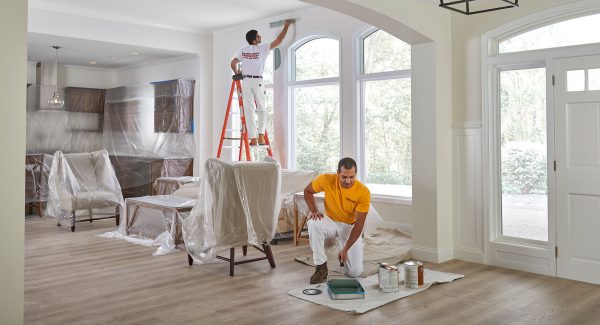Interior paint enhances the character and comfort of every room, but even the best finishes can face challenges over time. Whether you are a professional painter or an enthusiast maintaining your own space, knowing how to identify and correct these issues keeps walls looking flawless. If you have hired or are considering an Interior house painting Service, understanding these common problems and their remedies will help ensure a long-lasting, beautiful result.
Peeling or Flaking Paint
Peeling happens when paint loses adhesion and starts lifting away from the surface. Moisture infiltration, improper surface preparation, or painting over glossy or dirty surfaces are common culprits.
How to Fix?
-
Scrape off all loose paint using a putty knife or paint scraper.
-
Sand the edges to create a smooth transition between bare areas and remaining paint.
-
Clean the surface thoroughly and allow it to dry.
-
Apply a high-quality primer suitable for the surface.
-
Repaint using premium interior paint with proper drying time between coats.
Prevention Tip: Control indoor humidity and ensure walls are dry and clean before painting.
Cracking or Alligatoring
Cracks or an alligator-like texture often appear when paint ages, is applied too thickly, or when incompatible paint types are layered.
How to Fix?
-
Remove all cracked paint by scraping or sanding.
-
Fill hairline cracks with a flexible interior filler if needed.
-
Prime the repaired surface before applying fresh paint.
-
Apply thin, even coats of paint allowing sufficient drying time.
Prevention Tip: Always apply thin coats and avoid painting over oil-based paint with latex without proper primer.
Blistering or Bubbling
Blisters appear as raised paint bubbles and occur when moisture is trapped beneath the paint film or when painting over a hot or damp surface.
How to Fix?
-
Identify and correct the source of moisture (such as leaks or condensation).
-
Scrape and sand blistered areas once dry.
-
Re-prime with a moisture-resistant primer and repaint with quality paint.
Prevention Tip: Avoid painting in direct sunlight or on damp surfaces.
Fading or Discoloration
Fading is common in rooms exposed to strong sunlight or when low-quality paint is used. Over time, UV rays break down pigments, leading to a dull or uneven appearance.
How to Fix?
-
Repaint with high-quality, UV-resistant interior paint.
-
Choose colors with good lightfast ratings.
-
Add window treatments or UV-protective films to reduce direct sun exposure.
Prevention Tip: Always opt for premium paints with fade-resistant pigments.
Efflorescence
Efflorescence presents as white, powdery deposits on painted masonry surfaces, caused by salts in moisture migrating through walls.
How to Fix?
-
Brush off the white residue with a stiff, dry brush.
-
Locate and repair sources of water intrusion.
-
Once dry, apply a masonry sealer or primer before repainting.
Prevention Tip: Ensure proper waterproofing of masonry and adequate ventilation.
Mildew and Mold
Dark, spotty growth indicates mold or mildew, often found in bathrooms, kitchens, or damp basements.
How to Fix?
-
Clean the surface with a solution of one part bleach to three parts water.
-
Rinse thoroughly and let dry.
-
Repaint with a mildew-resistant interior paint.
Prevention Tip: Improve ventilation and use exhaust fans in high-humidity areas.
Lap Marks
Lap marks occur when wet and dry paint overlap unevenly, often due to improper technique.
How to Fix?
-
Sand the affected area lightly to blend.
-
Repaint the surface, maintaining a wet edge to avoid overlapping dry paint.
Prevention Tip: Work in small sections and keep a consistent painting rhythm.
Sagging or Drips
Paint that runs or sags usually results from applying overly heavy coats or painting in humid conditions.
How to Fix?
-
If wet, brush out the sagging paint immediately.
-
If dry, sand the area and reapply a thin coat.
Prevention Tip: Use thin coats and avoid overloading the brush or roller.
Chalking
Chalking shows up as a fine, white powder on painted surfaces, typically from aging paint or low-quality products.
How to Fix?
-
Wash off chalk residue with water and mild detergent.
-
Allow the wall to dry thoroughly.
-
Prime and repaint with a durable, high-quality paint.
Prevention Tip: Use paints formulated for interior surfaces and avoid low-grade options.
Stains and Streaking
Water leaks, smoke, or grease can cause unsightly stains or streaks.
How to Fix?
-
Identify and repair the source of staining.
-
Clean the surface and allow it to dry.
-
Apply a stain-blocking primer before repainting.
Prevention Tip: Regularly inspect for leaks or sources of smoke and clean surfaces promptly.
Quick Checklist for Professionals and Enthusiasts
-
Always prepare surfaces properly—clean, sand, and prime when required.
-
Invest in high-quality primers and paints to ensure longevity.
-
Control indoor humidity and temperature during and after painting.
-
Follow manufacturer’s instructions for drying times between coats.
-
Inspect painted surfaces periodically to catch problems early.
Why Choose Fitch Painting?
Fitch Painting is committed to delivering exceptional results with every project. From precise preparation to meticulous finishing, we ensure interiors remain vibrant and durable for years. Our dedication to quality materials, expert techniques, and attention to detail makes us a trusted choice for anyone seeking a flawless and long-lasting finish. When you want surfaces that stay beautiful and protected, Fitch Painting stands out as the reliable name for excellence.

